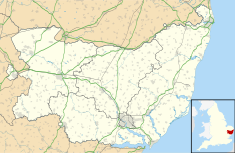Giffords Hall, Stoke-by-Nayland
| Giffords Hall | |||||||||||||||||||||||||||
|---|---|---|---|---|---|---|---|---|---|---|---|---|---|---|---|---|---|---|---|---|---|---|---|---|---|---|---|
 Giffords Hall Gatehouse
| |||||||||||||||||||||||||||
| |||||||||||||||||||||||||||
Giffords Hall (also called Gifford's Hall) is a Tudor manor house two miles north-east of Stoke-by-Nayland in Suffolk, England.[1] It was described by Nikolaus Pevsner as “one of the loveliest houses of its date in England”.[2] It takes its name from the powerful Gifford family, who owned it in the 13th century, alongside the similarly named Gifford's Hall, Wickhambrook.[3][4]
History
Sir Bernard Burke reported in 1854 that the then owner of the house had records for leases of parts of the estate dating from the reign of Henry II.[5]
The Constables
In 1216, Richard Constable began the now-ruinous chapel near the house, dedicating it to Saint Nicholas. Richard's son, William, would later "amply" endow the chapel.[1]
The Giffords
The manor of Giffords would gain its name from the Gifford family, who had large landholdings in the area, when Peter Gifford came to hold the manor in the reign of Henry III.
The Mannocks
The Mannock family was said to have hailed originally from Denmark, flourishing under England's Danish Monarchs.[6] Branches of the family had significant landholdings in Huntingdonshire, Cambridgeshire, Essex, and Suffolk,[7] with one established in Stoke-by-Nayland from the time of Edward III. Robert Mannock, alive in Edward's reign, was the great-grandfather of Philip Mannock,[7] who purchased the Giffords manor in 1427[1] or 1428.[8] The Mannock family and their successors would hold the house for nearly 500 years.[9][1] Following Philip's purchase, the estate would be expanded, for instance acquiring the manor of Raven's Hall in 1464.[10] remaining largely of only local importance.[11] Philip may have built the main ranges of the house today,[12] such as the Great Hall, at times (therefore incorrectly) called "King John's Banqueting Hall".[7] Philip would be succeeded by his son John, who would be succeeded by his son, George. George married Catherine, a daughter of Thomas Waldegrave of Smallbridge, Suffolk, and died on the 22 August 1541. His eldest son, William (d.1558), succeeded him. William (d.1558) would marry Audrie, a daughter of John Allington of Westley, Cambridgeshire and die on 8 July "6 Philip and Mary", i.e., 1558. His son, Francis (d.1590), was five years old at the inquisition a year later. He would later marry Mary, a daughter of William Fitch of Little Canfield, Essex, and kinswoman of Benet Canfield. When he died on 2 November 1590, he had multiple daughters but only one son, William (d.1617), who was 34 at the time. William (d.1617) would marry Etheldred, a daughter of Ferdinando Parys of Linton and die on 15 March "15 James I", i.e., 1617.[13][7]
Architecture
The current house is a mainly 16th century house built for the Mannocks, incorporating older fabric,[8] some of which may date to the Gifford family's ownership.[1] Its hall has a hammerbeam roof and a 2-storey Tudor red brick gatehouse.[8]
Gallery
Exterior
- Giffords Hall gatehouse from the South-West, pre-1900
- Giffords Hall gatehouse from the South-East, pre-1900
Courtyard and interior
- Giffords Hall courtyard and porch through the gatehouse
- Giffords Hall courtyard and hall range from the West, pre-1900
- Giffords Hall courtyard and hall range from the East
- Giffords Hall gatehouse's North façade from the courtyard, pre-1900
- Giffords Hall great hall from the West
Estate

The house is set within an agricultural estate.[14] It totalled 1,512 acres (612 ha) in 1918.[15]
References
- ^ a b c d e "Giffords Hall, Suffolk". Country Life. 14 (355): 578. 24 October 1903.
- ^ "Stoke by Nayland" (PDF). Dedham Vale Society. Retrieved 29 March 2021.[permanent dead link]
- ^ "Suffolk and Hertfordshire country houses for sale". Country Life. 10 March 2011. Retrieved 30 March 2021.
- ^ Historic England. "Details from listed building database (1235864)". National Heritage List for England.
- ^ Burke, Bernard (1854). A visitation of the seats and arms of the noblemen and gentlemen of Great Britain and Ireland. Vol. 1. London: Hurst and Blackett. p. 131. ISBN 0428498418.
- ^ Burke, Bernard (1854). A visitation of the seats and arms of the noblemen and gentlemen of Great Britain and Ireland. Vol. 1. London: Hurst and Blackett. p. 130. ISBN 0428498418.
- ^ a b c d "Giffords Hall, Suffolk". Country Life. 14 (355): 581. 24 October 1903.
- ^ a b c "GIFFORDS HALL". Historic England. Retrieved 29 March 2021.
- ^ Sibyl Thomas (13 January 2012), Heritage Statement, Kay Pilsbury Thomas Architects, p. 6-7
- ^ Nicolaas Joubert (December 2017), A Heritage Asset Assessment of The Pound, Hadleigh Road, Higham, Suffolk (PDF), Historic Buildings Consultant Ltd, p. 26
- ^ King, Chris (2003). "The Organization of Social Space in Late Medieval Manor Houses: an East Anglian Study". Archeological Journal. 160 (1): 109–110. doi:10.1080/00665983.2003.11078171. Retrieved 19 December 2024.
- ^ "Giffords Hall, Suffolk". Country Life. 14 (355): 578–581. 24 October 1903.
- ^ Burke, John (1838). A genealogical and heraldic history of the extinct and dormant baronetcies of England. London: Scott, Webster, and Geary. p. 337. ISBN 1294819879.
- ^ Kay Pilsbury Thomas Architects (1 February 2012), Design and Access Statement, Kay Pilsbury Thomas Architects, p. 2
- ^ Nicolaas Joubert (December 2017), A Heritage Asset Assessment of The Pound, Hadleigh Road, Higham, Suffolk (PDF), Historic Buildings Consultant Ltd, p. 12








